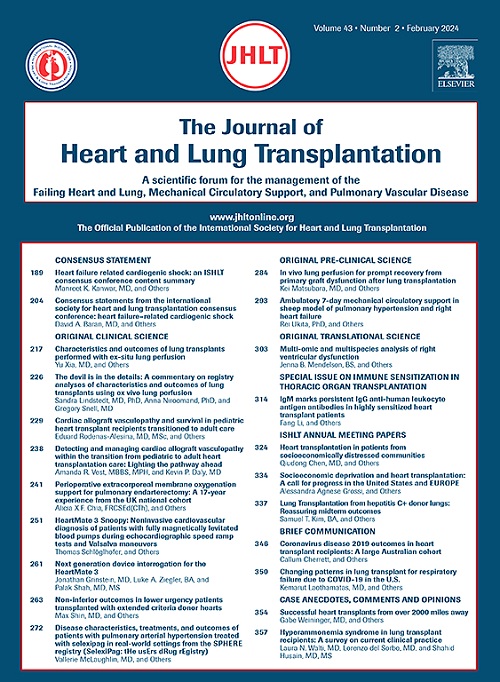Aortic insufficiency in the patient on contemporary durable left ventricular assist device support: A state-of-the-art review on preoperative and postoperative assessment and management
IF 6.4
1区 医学
Q1 CARDIAC & CARDIOVASCULAR SYSTEMS
引用次数: 0
Abstract
The development of aortic insufficiency (AI) during HeartMate 3 durable left ventricular assist device (dLVAD) support can lead to ineffective pump output and recurrent heart failure symptoms. Progression of AI often comingles with the occurrence of other hemodynamic-related events encountered during LVAD support, including right heart failure, arrhythmias, and cardiorenal syndrome. While data on AI burdens and clinical impact are still insufficient in patients on HeartMate 3 support, moderate or worse AI occurs in approximately 8% of patients by 1 year and studies suggest AI continues to progress over time and is associated with increased frequency of right heart failure. The first line intervention for AI management is prevention, undertaking surgical intervention on the insufficient valve at the time of dLVAD implant and avoiding excessive device flows and hypertension during long-term support. Device speed augmentation may then be undertaken to try and overcome the insufficient lesion, but the progression of AI should be anticipated over the long term. Surgical or transcatheter aortic valve interventions may be considered in dLVAD patients with significant persistent AI despite medical management, but neither intervention is without risk. It is imperative that future studies of dLVAD support capture AI in clinical end-points using uniform assessment and grading of AI severity by individuals trained in AI assessment during dLVAD support.

当代耐用左心室辅助装置支持患者的主动脉瓣关闭不全:术前和术后评估与管理的最新回顾。
在 HeartMate 3 耐用左心室辅助设备(dLVAD)支持过程中出现主动脉瓣关闭不全(AI)会导致泵输出无效和反复出现心衰症状。AI 的发展往往与 LVAD 支持期间遇到的其他血流动力学相关事件同时发生,包括右心衰竭、心律失常和心肾综合征。虽然有关使用 HeartMate 3 支持的患者的 AI 负担和临床影响的数据仍然不足,但约有 8% 的患者在使用 1 年后出现中度或更严重的 AI,而且研究表明 AI 会随着时间的推移继续发展,并与右心衰竭发生频率的增加有关。人工心肌缺血管理的一线干预措施是预防,在植入 dLVAD 时对瓣膜功能不全进行手术干预,并在长期支持期间避免设备流量过大和高血压。然后可以进行设备速度增强,尝试克服瓣膜功能不足的病变,但应预计到人工心肌缺血会长期发展。如果 dLVAD 患者尽管接受了药物治疗,但主动脉瓣仍存在严重的持续性缺血,则可考虑进行手术或经导管主动脉瓣介入治疗,但这两种介入治疗都没有风险。未来的 dLVAD 支持研究必须在 dLVAD 支持过程中,由接受过 AI 评估培训的人员对 AI 严重程度进行统一评估和分级,从而在临床终点中反映 AI 的情况。
本文章由计算机程序翻译,如有差异,请以英文原文为准。
求助全文
约1分钟内获得全文
求助全文
来源期刊
CiteScore
10.10
自引率
6.70%
发文量
1667
审稿时长
69 days
期刊介绍:
The Journal of Heart and Lung Transplantation, the official publication of the International Society for Heart and Lung Transplantation, brings readers essential scholarly and timely information in the field of cardio-pulmonary transplantation, mechanical and biological support of the failing heart, advanced lung disease (including pulmonary vascular disease) and cell replacement therapy. Importantly, the journal also serves as a medium of communication of pre-clinical sciences in all these rapidly expanding areas.

 求助内容:
求助内容: 应助结果提醒方式:
应助结果提醒方式:


